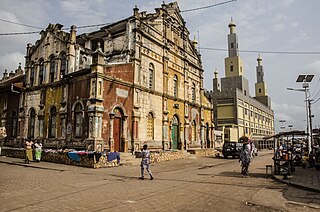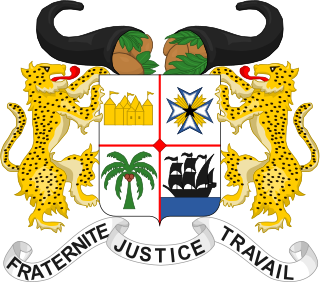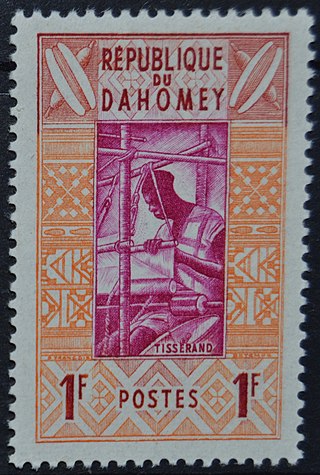Related Research Articles

Benin, officially the Republic of Benin, and also known as Dahomey, is a country in West Africa. It is bordered by Togo to the west, Nigeria to the east, Burkina Faso to the north-west, and Niger to the north-east. The majority of its population lives on the southern coastline of the Bight of Benin, part of the Gulf of Guinea in the northernmost tropical portion of the Atlantic Ocean. The capital is Porto-Novo, and the seat of government is in Cotonou, the most populous city and economic capital. Benin covers an area of 114,763 km2 (44,310 sq mi), and its population in 2021 was estimated to be approximately 13 million. It is a small, tropical country. It is one of the least developed, with an economy heavily dependent on agriculture, and is an exporter of palm oil and cotton. Some employment and income arise from subsistence agriculture.
The History of Benin since the 16th century, for the geographical area included in 1960 in what was then called the Republic of Dahomey before becoming the People's Republic of Benin.

Porto-Novo is the capital and second-largest city of Benin. The commune covers an area of 110 square kilometres (42 sq mi) and as of 2002 had a population of 223,552 people.

After seizing power in the 1972 coup d'état, Major Mathieu Kérékou declared the People's Republic of Benin a Marxist-Leninist state and sought financial support from communist governments in Eastern Europe and Asia. To distance the modern state from its colonial past, the country became the People's Republic of Benin in 1975. However, Benin dropped the socialist ideology in 1989 following pressure from creditors and domestic unrest related to economic hardship.

The national flag of Benin is a flag consisting of two horizontal yellow and red bands on the fly side and a green vertical band at the hoist. Adopted in 1959 to replace the French Tricolour, it was the flag of the Republic of Dahomey until 1975, when the People's Republic of Benin was established. The new regime renamed the country and changed the flag to a green field with a red star in the canton. This version was utilized until multi-party democracy was re-established in 1990, coinciding with the Revolutions of 1989. The new government promptly restored the original pre-1975 flag.

The coat of arms or national seal of Benin, originally introduced in 1964, was readopted in 1990 after being replaced in 1975.

.bj is the Internet country code top-level domain (ccTLD) for Benin. It is administered by the Office of Stations and Telecommunications of Benin. Despite having no "j" in its name in any of its official languages, Benin was allocated .bj as the other possible codes .be, .bn, and .bi had already been allocated to other entities.

The Benin national football team, nicknamed Les Guépards , represents Benin in men's international association football and are controlled by the Benin Football Federation. They were known as Dahomey until 1975, when the Republic of Dahomey became Benin.

French Dahomey, officially the Colony of Dahomey and Dependencies, was a French colony and part of French West Africa from 1894 to 1958. After World War II, by the establishment of the French Fourth Republic in 1947, Dahomey became part of the French Union with increased autonomy. On 4 October 1958 the French Fifth Republic was established, and the French Union became the French Community. The colony became the self-governing Republic of Dahomey within the Community, and two years later on 1 August 1960, it gained full independence, renamed to Benin in 1975.

The following outline is provided as an overview of and topical guide to Benin:

Albert Tévoédjrè was a Beninese writer and politician. He was Information Minister of Dahomey from 1960 to 1963.
Benin, officially the Republic of Benin, is a country in Western Africa. It borders Togo to the west, Nigeria to the east and Burkina Faso and Niger to the north; its short coastline to the south leads to the Bight of Benin. Its size is just over 110000 km2 with a population of almost 8500000. Its capital is the Yoruba founded city of Porto Novo, but the seat of government is the Fon city of Cotonou. About half the population live below the international poverty line of US$1.25 per day.

This is a survey of the postage stamps and postal history of Benin, formerly Dahomey.
L'Aube may refer to:
The following is a timeline of the history of the city of Cotonou, Benin.

Dada Kêfa Agbomantonligba Sagbadjou Glèlè was the King of Dahomey from 2019 until his death.
The Benin Air Force is the aerial service branch of the Benin Armed Forces. It was formed in 1960 when Benin gained independence from France as the Dahomey Air Force. The Air Force provides support to the army, primarily through transport and liaison, and presidential transportation. It has relied heavily on donations, initially from France and more recently from Belgium. During the short lived People's Republic of Benin, when it was known as the Benin People's Air Force, Soviet aircraft were acquired to demonstrate the change of political allegiance. The current operational fleet consists of two aircraft.
The Cinema of Benin refers to the film industry of the Republic of Benin in West Africa.

First Lady of Benin is the title attributed to the wife of the President of Benin. Claudine Talon, wife of Patrice Talon, became first lady on her husband's election as president on April 6, 2016. There had been no "first gentleman", or its equivalent, as of 2023.
References
- ↑ Agency, Central Intelligence (2015-01-01). The World Factbook. Masterlab. p. 402. ISBN 9788379912131.
- 1 2 "L'Hymne National du Bénin". Présidence de la République du Bénin (in French). Retrieved 2021-12-31.
- ↑ PDB France - Partage Diaspora Béninoise OFFICIEL (2020-05-12). "Hymne national du Bénin en Fongbé - Bédhy". YouTube. Archived from the original on 2022-01-01. Retrieved 2022-01-01.
{{cite web}}: CS1 maint: bot: original URL status unknown (link)